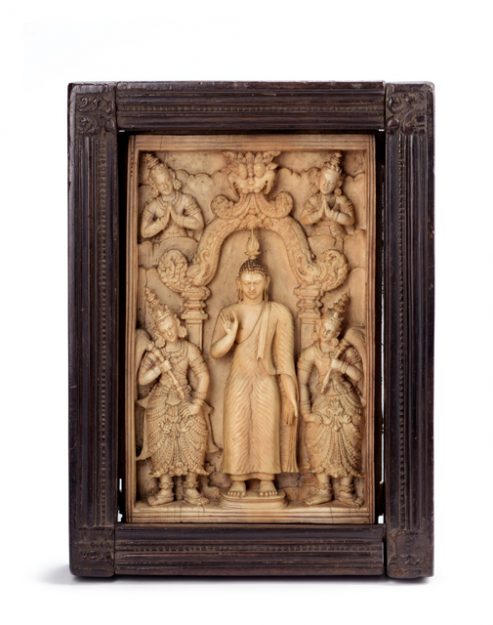The rarest and most valuable Sri Lankan jewel of all is not on display at the Los Angeles County Museum of Art’s current exhibition The Jeweled Isle: Art from Sri Lanka. It isn’t the 407-carat topaz, or even the 3,339-carat lemon quartz seen shining in the first gallery, along with 19 other exquisite gems mined on the island. Rather, it is the tooth relic of the Buddha, sent from India in the 4th century, whose history was closely interwoven with the royal families of Sri Lanka and their ruling capitals.
The Los Angeles County Museum of Art (LACMA) exhibition is organized chronologically into three sections, based on three successive capital cities, each of which once housed the sacred tooth relic. More than 240 objects on display tell the story of Buddhism’s introduction to Sri Lanka, including its accommodation of indigenous deities and beliefs, its interaction with Hinduism, and its ties to Indian culture and visual forms. The objects also show the Portuguese, Dutch, and British colonial influences on Sri Lankan culture, the development of Sri Lankan decorative traditions, the richness of its courtly arts, and, last but not least, the legacy of these influences in modern-day Sri Lanka.
It was a surprise for this museumgoer to learn that the exhibition is the first comprehensive survey of Sri Lankan art organized by any museum in the United States. Many of the objects on display are from LACMA’s own collections—the most expansive and diverse holdings in the US—and the University of California, Los Angeles, the home institution of Robert L. Brown, co-curator with The LACMA’s Tushara Bindu Gude, is the only university in the country to teach Sri Lankan art.
A longtime ban on removing art from the island and a 25-year civil war that ended only in 2009 created a gap in Sri Lankan scholarship. A survey of the country’s art was long overdue. The result is an ornate, colorful, and diverse panorama of objects and images.
The exhibition’s images of the Buddha are perhaps the most intriguing of all. These have a genuine, deep-rooted quality relatively lacking in the colonial pieces. Elegant in repose, seated in meditation, or standing in assurance, these figures emanate reverence and devotion in a way that seems to have been lost once European influences arrived. There is one example, however, of the melding of native and European styles that succeeds in capturing the best of both worlds: a dense, lushly carved 18th-century ivory scene in an ebony frame, Buddha Shakyamuni and Attendants. Here the native carver has married a European-style format, a rectangular frame bordering a frontal relief, with pure Sri Lankan imagery: an elegant Buddha figure under an intricately decorated arch, flanked by ornately dressed figures, while two others float above on clouds.

Bright polychromatic figures abound in later and modern artworks as they do in the famous annual tooth relic pro-cession in Kandy, replete with decorated elephants, masses of richly costumed performers, lights, and flowers. Also on display at LACMA are a number of wooden shrine panels from the 17th and 18th centuries whose paintings depict the incorporation of Indian gods, some clearly Hindu, into a protective pantheon of Sri Lankan Buddhist figures.
Escher GuneWardena Architecture, the exhibition’s designer, came up with the show’s layout after examining the objects’ historical settings and elements of ancient Sri Lankan architecture. According to their statement, the placement of monochromatic, monolithic forms are meant to suggest ruins extruding from the ground plane. While some of these effects work quietly and effectively on the viewer, I found the resulting dark charcoal-gray rooms rather cave-like and too distant from the verdant, light-filled, and spectacularly beautiful environment that is home to all the objects on display. Where the designers do back certain objects with panels colored in pigments that are evocative of Sri Lankan culture, the effect is lovely, and the pieces come alive.
Sri Lanka gained independence from the British in 1948 after more than four hundred years of European colonial rule. The country took its present name in 1972, doing away with “Ceylon,” the anglicized form of the Portugese Ceilao (based on a native term, Sinhala). Offering viewers a broad historical and visual context, the LACMA exhibition is interspersed with late 19th-century British colonial photographs that depict landscapes, sacred sites, monuments, botanical studies, and portraits of Kandyan elites from its modern history.
As a counterpoint to the colonial images, a wall at the end of the exhibition displays 20th-century photos by Reg van Cuylenburg (1926–1988), a Sri Lankan native of Kandyan, Sinhalese, English, and Dutch descent. Taken primarily in the 1950s, these photos present dignified images of fellow countrymen in a beloved homeland. Such is the jeweled isle celebrated in this exhibition—a place whose vibrant artistic culture spans more than two millennia.
♦
The Jeweled Isle: Art from Sri Lanka runs through June 23, 2019, at The Los Angeles County Museum of Art.